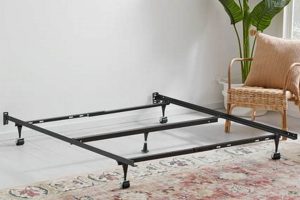The compatibility of mattress and bed frame sizes is critical for proper support and comfort. A mismatch can lead to inadequate support, potential damage to the mattress, and an uncomfortable sleep experience. Specifically, attempting to place a larger mattress on a smaller frame presents significant challenges.
Using appropriately sized components ensures the mattress’s longevity and allows it to provide the intended support. A frame that is too small will not evenly distribute weight, leading to premature wear on the mattress. Additionally, an unsupported mattress may sag or deform over time, diminishing its comfort and potentially voiding any warranty.
The following discussion will detail the dimensional differences between a queen-size mattress and a full-size bed frame, highlighting the reasons why they are not interchangeable and exploring the possible consequences of attempting such a combination.
Considerations Regarding Mattress and Bed Frame Compatibility
Selecting the correct mattress and bed frame pairing is essential for optimal sleep quality and longevity of bedding. Attempting to force an incompatible match can result in various issues.
Tip 1: Measure the dimensions of both the mattress and the bed frame. A queen-size mattress typically measures 60 inches wide by 80 inches long, while a full-size bed frame is designed for a mattress measuring 54 inches wide by 75 inches long. The size discrepancy is significant.
Tip 2: Acknowledge that a queen mattress overhangs a full frame. The six-inch width difference and five-inch length difference mean a queen mattress will extend beyond the edges of a full-size frame. This creates an unstable and unsafe sleeping surface.
Tip 3: Understand the impact on mattress support. A full-size frame will not adequately support the entire area of a queen-size mattress. This can lead to sagging, uneven wear, and a reduction in the mattress’s lifespan.
Tip 4: Consider the potential for frame damage. The added weight and pressure of a queen mattress on a frame designed for a smaller mattress may stress the frame’s structural integrity, potentially leading to breakage or instability.
Tip 5: Evaluate the implications for sleep quality. The unstable and unsupported nature of a queen mattress on a full frame can disrupt sleep and cause discomfort. It might be a cheaper option but long term wise will damage both the full-size bed frame and the queen mattress.
Tip 6: When purchasing a mattress, verify its compatibility with the existing bed frame or purchase a matching frame. This ensures proper support and avoids the aforementioned issues.
Ensuring correct sizing prevents damage and promotes sound sleep.
The next section will summarize key benefits for those that purchase correctly sized mattress and bedframe.
1. Incompatible Dimensions
The dimensional discrepancy between queen and full-size mattresses and bed frames forms the core reason for their incompatibility. This difference impacts support, stability, and overall functionality, rendering the combination impractical.
- Queen Mattress Size
A queen mattress adheres to standardized dimensions of 60 inches in width and 80 inches in length. These measurements are designed to accommodate two adults comfortably, offering adequate personal space during sleep.
- Full Bed Frame Size
A full-size bed frame, conversely, is designed for mattresses with dimensions of 54 inches in width and 75 inches in length. This smaller size is typically suited for single sleepers or smaller bedrooms where space is limited.
- Overhang and Instability
The difference of 6 inches in width and 5 inches in length means a queen mattress will extend beyond the perimeter of a full-size frame. This overhang creates an unstable sleeping surface, particularly along the mattress edges. This can cause a hazard for people who don’t know that a Queen mattress extends beyond the frame.
- Lack of Support
A full bed frame will not evenly support a queen mattress. The central area of the mattress may be adequately supported, but the edges will lack the necessary foundation. This can lead to sagging, uneven wear, and a reduced lifespan for the mattress.
In summary, the fundamental dimensional differences between queen mattresses and full-size bed frames preclude their successful combination. Attempting to use a queen mattress on a full frame results in instability, inadequate support, and potential damage to both the mattress and the frame itself.
2. Inadequate Support
Inadequate support is a direct consequence of attempting to place a queen mattress on a full bed frame. The dimensional mismatch leads to a compromised structural foundation, negatively impacting the mattress’s performance and longevity.
- Uneven Weight Distribution
A full bed frame, designed for a smaller mattress, cannot evenly distribute the weight of a queen mattress. This results in concentrated pressure points, particularly in the center of the mattress, while the edges receive little to no support. Over time, this uneven distribution can lead to sagging and deformation of the mattress core. For example, if two adults sleep primarily on the edges, the center of the mattress might remain firm while the edges compress and lose their original shape. This uneven wear diminishes the mattress’s overall lifespan and comfort.
- Compromised Spinal Alignment
Proper spinal alignment is crucial for comfortable and restful sleep. Inadequate support from an undersized bed frame can compromise this alignment. When parts of the mattress lack support, the sleeper’s body may sink or tilt, creating unnatural curves in the spine. This misalignment can lead to back pain, stiffness, and other musculoskeletal issues. For example, a side sleeper might find their hips sinking lower than their shoulders due to the lack of edge support, placing undue stress on the lower back.
- Reduced Mattress Lifespan
The stresses placed on a mattress due to inadequate support accelerate its deterioration. The constant pressure on unsupported areas causes the internal components, such as springs or foam layers, to break down prematurely. This reduces the mattress’s overall lifespan, necessitating earlier replacement. As an illustration, the edges of a queen mattress placed on a full frame might begin to sag and lose their firmness within a year or two, whereas a properly supported mattress could maintain its shape and support for several years longer.
- Voided Warranty
Many mattress manufacturers specify that their products must be used with a properly sized and supportive bed frame. Using an undersized frame can be considered misuse, potentially voiding the mattress warranty. If the mattress exhibits sagging or other signs of premature wear, the manufacturer may deny a warranty claim if it’s determined that the mattress was not adequately supported. It’s important to review the warranty terms and conditions to ensure compliance with the manufacturer’s requirements.
The issue of inadequate support underscores the importance of matching mattress and bed frame sizes. Failure to do so can lead to a cascade of negative consequences, from compromised comfort and health to reduced mattress lifespan and voided warranties. In essence, the slight cost of a proper bed frame is justified by ensuring that the longevity and quality of the mattress is preserved.
3. Mattress Overhang
Mattress overhang is an unavoidable consequence when a queen mattress is placed on a full bed frame. This situation arises due to the dimensional incompatibility between the two, presenting several practical and functional concerns. The overhang directly impacts stability, support, and the overall sleeping experience.
- Edge Instability
The portion of the mattress extending beyond the frame lacks direct support, creating an unstable edge. Sitting or sleeping near the edge can cause the mattress to sag or tilt, increasing the risk of falls and discomfort. This instability concentrates weight on a smaller area of the frame, potentially accelerating wear or damage. For example, consistent sitting on the overhanging edge will cause the mattress to compress and deform, leading to a permanent sag.
- Compromised Aesthetics
Mattress overhang detracts from the visual appeal of the bed. The mismatched sizes create an awkward and unfinished appearance. Bedding may not fit properly, and the overall aesthetic coherence of the bedroom is disrupted. This can be a particular concern in situations where bedroom decor is carefully coordinated.
- Increased Wear and Tear
The unsupported portion of the mattress experiences increased stress and friction, leading to accelerated wear and tear. The fabric may fray, and the internal components can degrade more quickly. The overhanging edge is more vulnerable to damage from impacts or abrasions. As an illustration, frequent contact with a wall can rub away the fabric on the overhanging edge, exposing the mattress interior.
- Safety Hazards
The overhanging mattress edge can present a tripping hazard, particularly in dimly lit rooms. The uneven surface creates an obstacle that is easy to overlook, increasing the risk of accidents. Small children and elderly individuals are particularly vulnerable. For instance, someone walking around the bed at night might trip over the unseen edge of the mattress, resulting in a fall.
The factors associated with mattress overhang, resulting from the attempt to fit a queen mattress on a full bed frame, highlight the functional and safety considerations that necessitate using appropriately sized components. Proper fit ensures stability, support, and preserves the longevity of both the mattress and frame. These also have a direct impact on sleep quality.
4. Frame Instability
Frame instability is a significant concern when considering whether a queen mattress fits on a full bed frame. The design of a full bed frame anticipates a specific weight distribution and support structure, which is compromised when a larger, heavier queen mattress is used.
- Compromised Weight Distribution
Full bed frames are engineered to support the weight of a full-size mattress and its occupants. When a queen mattress is placed on a full frame, the weight is no longer distributed as intended. This uneven distribution can stress specific points on the frame, potentially leading to bending, cracking, or complete failure. For example, the center supports may buckle under the additional weight, or the side rails may warp over time. This compromise of the structural integrity can occur gradually, and will result in an eventual collapse.
- Increased Risk of Structural Failure
The additional weight and dimensional mismatch can place undue stress on the frame’s joints and connections. Screws may loosen, welds may crack, and wooden components may splinter. This increases the risk of the frame collapsing, posing a safety hazard to the occupants. A sudden collapse during sleep can cause injury and damage to the mattress and surrounding furniture. Furthermore, this compromises the support to the spinal support from the mattress, which can lead to bad posture.
- Reduced Frame Lifespan
Even if the frame does not immediately collapse, the added stress will accelerate its wear and tear. The frame may become wobbly, squeaky, or unstable over time. The reduced stability can also affect the sleep quality and overall comfort. For example, the frame may creak or shift with every movement, disrupting sleep and causing discomfort. Moreover, increased movement can create noise due to structural deficiency.
- Inadequate Edge Support
Since a queen mattress overhangs the edges of a full bed frame, there is a lack of support along the mattress perimeter. This can create an unstable sleeping surface near the edges, making it difficult to get in and out of bed. It also increases the risk of rolling off the bed during sleep. A person sitting or lying near the edge of the bed may experience a sinking or tilting sensation, making it feel unsafe and uncomfortable.
The instability resulting from placing a queen mattress on a full bed frame can lead to several negative consequences, ranging from accelerated wear and tear to potential structural failure and safety hazards. Proper consideration of the frame structure integrity will make sure a good night sleep is achieved. It is therefore crucial to ensure that the mattress and bed frame are appropriately matched in size and weight capacity to ensure proper support, stability, and safety.
5. Compromised Sleep
The suitability of a queen mattress on a full bed frame bears a direct relationship with sleep quality. A mismatch in size between the mattress and frame introduces instability and inadequate support, factors that negatively affect sleep. This is because a full bed frame, designed for a smaller mattress, cannot evenly distribute the weight of a queen mattress. The resulting unevenness leads to pressure points and a lack of support, causing discomfort and restlessness throughout the night. A real-life example is a sleeper experiencing back pain due to the sagging of the unsupported areas of the mattress, necessitating frequent position changes and disrupting the natural sleep cycle.
Further contributing to compromised sleep is the mattress overhang, a natural consequence of placing a queen mattress on a full frame. This overhang creates an unstable edge, making sleepers reluctant to utilize the full mattress surface. This leads to restricted movement during sleep and increased risk of falling off the bed. Moreover, the frame’s inability to adequately support the larger mattress compromises spinal alignment. An individual’s spine may be forced into unnatural curves, resulting in muscle strain and discomfort. This misalignment can lead to chronic pain, further impeding sleep quality.
In conclusion, the attempt to accommodate a queen mattress on a full bed frame creates a sleeping environment characterized by instability, inadequate support, and compromised spinal alignment. These factors directly lead to restless sleep, discomfort, and potential long-term health issues. Ensuring compatibility between mattress and frame sizes is therefore crucial for promoting healthy sleep patterns and overall well-being.
Frequently Asked Questions
This section addresses common inquiries regarding the compatibility of queen mattresses with full bed frames, providing clarity on potential issues and consequences.
Question 1: What are the dimensional differences between a queen mattress and a full bed frame?
A queen mattress typically measures 60 inches wide by 80 inches long. A full bed frame is designed for a mattress measuring 54 inches wide by 75 inches long. This size discrepancy is the primary reason for incompatibility.
Question 2: Will a queen mattress damage a full bed frame?
The additional weight and size of a queen mattress can place undue stress on a full bed frame. This can lead to bending, cracking, or eventual collapse of the frame, reducing its lifespan.
Question 3: Does a queen mattress on a full frame affect sleep quality?
The lack of proper support and potential for mattress overhang can create an uneven and unstable sleeping surface. This can lead to discomfort, restlessness, and compromised spinal alignment, negatively impacting sleep quality.
Question 4: Is it possible to modify a full bed frame to accommodate a queen mattress?
While some modifications might seem feasible, they typically require significant structural alterations. These modifications may compromise the frame’s integrity and are generally not recommended. It is typically not a safe and feasible option.
Question 5: Can the mattress warranty be affected by using an improperly sized frame?
Many mattress warranties stipulate the use of a properly sized and supportive frame. Using a full bed frame with a queen mattress may void the warranty in the event of sagging or other damage.
Question 6: What are the long-term consequences of using a queen mattress on a full frame?
Long-term use can result in premature wear of both the mattress and the frame, compromised sleep quality, and potential safety hazards due to instability.
In summary, attempting to use a queen mattress on a full bed frame presents several significant challenges. These include dimensional incompatibility, potential damage to the frame and mattress, compromised sleep quality, and potential safety hazards.
The next section will provide alternative solutions for those seeking to upgrade their sleeping arrangements.
Conclusion
The preceding analysis clarifies that the inquiry “can a queen mattress fit on a full bed frame” warrants a negative response. The dimensional disparities between these mattress and frame sizes preclude a safe and supportive configuration. Attempting such a pairing introduces potential for structural damage to the frame, premature wear of the mattress, and a compromised sleep experience.
Therefore, adherence to established size standards is paramount for ensuring optimal comfort, durability, and safety. Investment in appropriately sized bedding components represents a judicious decision, promoting long-term well-being and mitigating potential risks associated with incompatible pairings. Furthermore, confirming support capacity on both is highly encouraged prior to purchase.


![Best California King Mattress & Frame [Guide] Organic & Natural Mattress Buyer’s Guide: Non-Toxic Sleep Solutions Best California King Mattress & Frame [Guide] | Organic & Natural Mattress Buyer’s Guide: Non-Toxic Sleep Solutions](https://mattressworldpa.com/wp-content/uploads/2025/07/th-3075-300x200.jpg)
![Best Full Size Mattress Metal Frame [Guide & Tips] Organic & Natural Mattress Buyer’s Guide: Non-Toxic Sleep Solutions Best Full Size Mattress Metal Frame [Guide & Tips] | Organic & Natural Mattress Buyer’s Guide: Non-Toxic Sleep Solutions](https://mattressworldpa.com/wp-content/uploads/2025/07/th-3074-300x200.jpg)

![Best Mattress Firm Platform Frame [Guide] Organic & Natural Mattress Buyer’s Guide: Non-Toxic Sleep Solutions Best Mattress Firm Platform Frame [Guide] | Organic & Natural Mattress Buyer’s Guide: Non-Toxic Sleep Solutions](https://mattressworldpa.com/wp-content/uploads/2025/07/th-3072-300x200.jpg)

